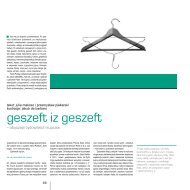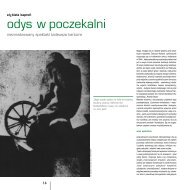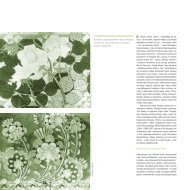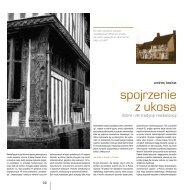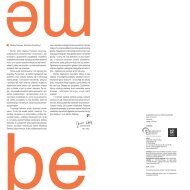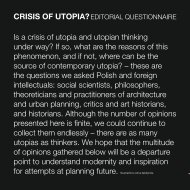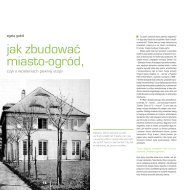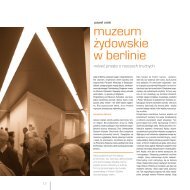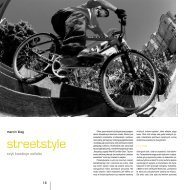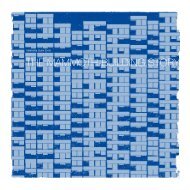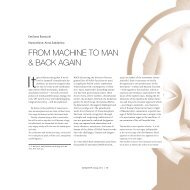zakopane style − national style - Autoportret
zakopane style − national style - Autoportret
zakopane style − national style - Autoportret
Create successful ePaper yourself
Turn your PDF publications into a flip-book with our unique Google optimized e-Paper software.
muzeum tatrzańskie w <strong>zakopane</strong>m<br />
Around the turn of the century<br />
a number of different architectural<br />
<strong>style</strong>s, each with its own advocates,<br />
vied for the accolade of acknowledgement<br />
as the ‘<strong>national</strong> <strong>style</strong>’ (styl narodowy).<br />
In fact, during the final two decades of the<br />
Polish partitions much ‘objective’ thought<br />
was given by architectural historians and<br />
architects to the constituent forms of native<br />
architectural traditions. Szymon Szyller, the<br />
architect of Warsaw’s Poniatowski Bridge of<br />
1905, published a grammar of Polish architectural<br />
forms under the title of Tradycja<br />
budownictwa ludowego w architekturze polskiej<br />
(Native Building Traditions in Polish Architecture,<br />
1917), the result of years of architectural<br />
‘archeology’. Szyller, in his own<br />
architectural practice, favoured a Renaissance<br />
<strong>style</strong> derived from sixteenth- and seventeen-<br />
David Crowley<br />
<strong>zakopane</strong> <strong>style</strong><br />
<strong>−</strong> <strong>national</strong> <strong>style</strong><br />
th-century buildings found in central Poland<br />
(usually designed by Italian architects). He<br />
was responsible for the restoration of the<br />
cathedral at Płock in 1902<strong>−</strong>03 which contained<br />
both romanesque and Renaissance elements. 1<br />
Others, such as Józef Pius Dziekoński, favoured<br />
a pointed variant of the Gothic known as<br />
Vistula-Baltic Gothic (Gotyk Nadwiślański). He<br />
designed Warsaw’s St Florian’s church, built<br />
between 1888 and 1901, in this <strong>style</strong>. Although<br />
highly influenced by the ideas of the English<br />
and French Gothicists, and Eugène Viollet-le-<br />
Duc in particular, 2 Polish advocates of this <strong>style</strong><br />
believed that they had identified <strong>national</strong><br />
characteristics in the Gothic found in towns<br />
1 An earlier restoration of the cathedral had been made<br />
in the sixteenth century by Italian craftsmen led by<br />
two architects, J. Cini and B. Zanobi de Gianotis. See<br />
W. Budka, ‘Działalność architektów I rzemieślnikó przy<br />
restauracji katedry płockiej w XVI w.’ in Rzeczy Piękne,<br />
no. 5, 1925.<br />
2 Viollet-le-Duc, in fact, was employed as an advisor during<br />
rebuilding of the castle at Gołuchów in 1872 and the<br />
Czartoryski Museum in Cracow in 1878. See A. Miłobdz- Miłobdz-<br />
ki, Zarys dziejów architektury w Polsce, Wiedza Powszechna,<br />
Warsaw, 1978, p. 296.<br />
autoportret 3 [32] 2010 | 32<br />
along the Vistula river in the north of Poland.<br />
Despitc their pretensions to architectural ‘archeology’,<br />
these advocates of historicism were<br />
largely motivated by aesthetic proclivities.<br />
The claims made for the vernacular architecture<br />
and design from the Podhale region,<br />
then under the rule of the Habsburgs, whilst<br />
certainly no less exaggerated than those<br />
for the Gothic, held greater significance for<br />
the history of design in Poland. For Podhale<br />
culture not only caught the imagination of<br />
a great number of architects and designers,<br />
but Polish society across all three partitions.<br />
In the nineteenth century the town of Zakopane<br />
was the regional centre of the Podhale<br />
area, the northern foothills below the Tatra<br />
mountains. It was largely populated by an<br />
ethnically and linguistically distinct people,<br />
the Górale (Highlanders). 3 Podhale was one of<br />
3 The Górale migrated from the East to Europe in the<br />
twelfth century. Even today they remain distinct ethnic<br />
group within Polish society in terms of language and<br />
social codes.
the poorest and most isolated areas, claimed<br />
as Polish by <strong>national</strong>ists, in the Austro-Hungarian<br />
Monarchy. Untouched by industry,<br />
its population survived as farmers and<br />
shepherds on the forested slopes and valleys<br />
of the Tatrs. A key figure of the region was<br />
a doctor, botanist, <strong>national</strong> activist and<br />
mountaineer, Tytus Chałubiński, who had<br />
been a professor at the Warsaw Academy of<br />
Surgical Medicine until 1871. He came from<br />
Warsaw to stay in Zakopane for the first time<br />
in l873 to combat a cholera epidemic. 4 This<br />
4 Although, according to the myths which have surrounded<br />
Chałubiński’s life, he first saw the Tatras as<br />
a defeated liberal in 1849 fleeing from the Habsburg<br />
authorities: the mountains offered sanctuary.<br />
experience led him to become one of the<br />
founders of the Tatra Society (Towarzystwo<br />
Tatrzańskie) in that year. As an institution<br />
established to promote and preserve Górale<br />
ways of life, the Tatra Society was a classic<br />
example of the <strong>national</strong>ist / Positivist strategy<br />
of the institutionalisation and maintenance<br />
of Polish culture. 5 The Society sought<br />
to improve the social conditions of the local<br />
population and was a major force behind the<br />
establishment of a technical school in the<br />
town to harness the skills of local carpen-<br />
5 J. Bieniarzówna and J.M. Małecki, Dzieje Krakowa, III,<br />
Wydawnictwo Literackie, Cracow, 1985, p. 297; L. Długołcka<br />
and M. Pinkwart, Zakopane <strong>−</strong> przewodnik historyczny,<br />
Wyd. PTTK ‘Kraj’, Warsaw 1989, p. 18.<br />
autoportret 3 [32] 2010 | 33<br />
muzeum tatrzańskie w <strong>zakopane</strong>m<br />
Rówień Krupowa (Krupowa plain), ca. 1876-1878<br />
On previous page: the way to Morskie Oko, 1902<br />
ters and wood craftsmen in 1876. 6 It was also<br />
a major promoter of the region as a health<br />
resort, and Chałubiński, in particular, has<br />
been credited as the ‘discoverer of Zakopane’<br />
(odkrywca Zakopanego) for encouraging the<br />
bourgeoisie and intelligentsia to come to<br />
the area to rest and recuperate in the pure<br />
mountain air. Under the influence of figures<br />
like Chałubiński, Zakopane became a major<br />
health resort attracting wealthy Poles from<br />
across all the partitions. Whilst the very<br />
richest built Alpine-<strong>style</strong> villas as summer<br />
retreats, the less affluent stayed in the town’s<br />
many sanatoria.<br />
The Podhale region symbolised a freedom<br />
unavailable in the rest of the partitions. Its<br />
isolation made it a place where Polish life<br />
was unhindered by the oppressions of the<br />
Austro-Hungarian Monarchy: be they the infamous<br />
web of petty bureaucracy that fettered<br />
the Monarchy together or the enervating<br />
politics of compromise in Vienna. 7<br />
Hej za mną w Tatry! w ziemi czarów,<br />
Hey with me through the Tatras! into this magic<br />
land<br />
Na strome szczyty gór!<br />
On to cliff tops!<br />
Okiem rozbijem dal obszarów,<br />
Our gaze will collapse distant territories,<br />
6 See H. Kenarowa, Od Zakopiańskiej Szkoły Przemysłu Drzewnego<br />
do Szkoły Kenera, Wydawnictwo Literackie, Cracow,<br />
1978.<br />
7 In fact, the montainous region around Zakopane was<br />
virtually tax-free because the Górale refused to pay<br />
duties and Vienna’s bureaucrats were unable to collect<br />
them.
Czołami signiem chmur.<br />
Our foreheads will touch the clouds. 8<br />
Furthermore, this mountainous region’s<br />
untouched natural beauty appeared evidence<br />
of an intact and ‘pure’ Poland. Halina Kenarowa,<br />
a historian, employing the familiar<br />
language of Polish messianism, described the<br />
significance of the Tatra mountains in this<br />
way: ‘They were the Polish altarpiece during<br />
the partitions.’ 9<br />
It was not a great leap to extend this vision<br />
of an uncontaminated Polish nature to the<br />
local Górale people; their lives, dress, tradi-<br />
8 W.L. Anczyc, ‘W Tatry!’, 1876, in. M. Jagiełło (ed.), Tatry<br />
w poezji i sztuce polskiej, Wydawnictwo Literackie, Cracow,<br />
1975, p. 132.<br />
9 H. Kenarowa, in conversation in Zakopane in October<br />
1987.<br />
tions and possessions. 10 In 1886 Stanisław<br />
Witkiewicz, an artist and art critic from<br />
Warsaw, visited the Tatra mountains for the<br />
first time. As both natinalist and a fervent<br />
opponent of historicism in the arts, he found<br />
Górale architectural and decorative traditions<br />
what he later argued to be the essence of Po-<br />
10 Interest with peasant cultures in Poland was not restricted<br />
to the Zakopane region alone. Many Poles were<br />
actively recording vernacular culture in the Russian<br />
partition through associations such as the Polish Society<br />
for the Investigation of the Country (Polskie Towarzystwo<br />
Krajoznawcze). See M. Wawrzeniecki, ‘The Peasant Art of<br />
Russian Poland’ in C. Holmes (ed.), Peasant Art in Russia,<br />
The Studio, London, 1912, pp. 35-42.<br />
autoportret 3 [32] 2010 | 34<br />
„architekt” r. i, 1900, nr 6, tabl. iv<br />
Franciszek Mączyński, a design of villa “Réjane”<br />
(1900); 1 st award at the “Villa Moderne” competition<br />
organized by the “Moniteur des Architects”<br />
lish culture in form. 11 This material culture<br />
seemed not insullied by the partitions but<br />
free of all foreign traces, like a living fossil<br />
formed ‘when the characteristics of <strong>national</strong><br />
genius were consolidated and fixed’. 12 Witkiewicz<br />
was much taken with the vernacular<br />
Górale homes: long, low wooden cabins<br />
constructed from great logs and insulated<br />
with straw; topped with a wooden-slatted,<br />
half-gable roof with deep overhanging eaves.<br />
They were characteristically decorated with<br />
simple, geometric patterns or plant forms on<br />
the door-frame or across the main structural<br />
beams inside the house. At the same time<br />
Witkiewicz and his supporters were also<br />
greatly concerned with the spread of ‘Alpine’<br />
chalets erected by wealthy Poles from outside<br />
the region. His friend, Stanisław Eljasz-<br />
Radzikowski, recalling the 1880s, wrote in<br />
1901: ‘Zakopane was already covered with thc<br />
homes of the squirearchy and drab cosmopolitan<br />
homes in a Swiss-<strong>style</strong>. It seemed that<br />
the native Górale cabin would disappear because<br />
many of them built homes quickly, and<br />
in speculation, in the <strong>style</strong> of the gentry.’ 13<br />
11 Although Witkiewicz rejected contemporary trends in<br />
painting emanating from Paris and Munich as the absurd<br />
pursuit of novelty, he was not a traditionalist. Like<br />
Ruskin (to whom he is often compared), he sought a moral<br />
and social art and design practice. He is renowned an<br />
often dictum: ‘It is better to paint the head of a cabbage<br />
accurately than the head of Christ badly.’ Accordingly he<br />
was a forceful advocate of realism in the arts and a strong<br />
critic of historicism. See W. Noakowska, Stanisław Witkiewicz:<br />
teoretyk sztuki, Ossolineum, Wrocław, 1970.<br />
12 J. Topass, L’art et Les Artistes en Pologne du Romantisme à<br />
Nos Jours, Librairie Félix Alcan, Paris, 1928, p. 145.<br />
13 S. Eljasz-Radzikowski, Styl Zakopiański, Cracow, 1901,<br />
p. 17.
muzeum tatrzańskie w <strong>zakopane</strong>m<br />
Witkiewicz claimed the ‘discovery’ of the<br />
roots of a Polish <strong>national</strong> <strong>style</strong> in the wooden<br />
vernacular architecture of the region. Significantly,<br />
in this he differed from the supporters<br />
of historicist models which sought to<br />
restore particular architectural languages so<br />
as to revive the values of a particular historical<br />
epoch: the Renaissance and Gothic <strong>style</strong>s<br />
found advocates and intellectual justification<br />
as the fruits of ‘golden ages’ in Polish<br />
history. In contrast, the promotion of Zakopane<br />
Style (Styl Zakopiański) can be regarded<br />
as an example of what Adam Miłobdzki has<br />
identified in central Europe as ‘the Romanlic<br />
idealisalion of the peasantry, and the unflin-<br />
autoportret 3 [32] 2010 | 35<br />
muzeum tatrzańskie w <strong>zakopane</strong>m<br />
Villa Koliba, designed by Stanisław Witkiewicz,<br />
ca. 1894<br />
Below: a room of Zygmunt Gnatowski in Koliba,<br />
ca. 1894<br />
ching trust that in this peasant culture the<br />
authentic, unchanging traits of <strong>national</strong><br />
tradition have been preserved’. 14 True to this<br />
prescription, Witkiewicz argued, contrary to<br />
ethnographic evidence, that the peasant material<br />
culture of the Podhale region held the<br />
last vestiges of a <strong>style</strong> that at some unspecified<br />
time in the past had been found all over<br />
Poland, and now only remained in the then<br />
near inaccessible foothills of the Tatras. 15<br />
In the 1890s Witkiewicz, then a resident of<br />
Zakopane, and his colleagues; architects, Julian<br />
Orchowicz, Stanisław Porczyński, Teodorc<br />
Burze, and Eugeniusz Wesołowski, Stanisław<br />
Barabasz, and literary propagandists such as<br />
Stanisław Eljasz-Radzikowski, collectively and<br />
self-consciously set about recasting the raw<br />
materials that they had found in Zakopane<br />
into an intellectually complex decorative and<br />
architectural language. Witkiewicz wrote in<br />
a letter to his sister in 1898: ‘We build more.<br />
One home is completed, two more are under<br />
way. Zakopane is developing well, in its own <strong>style</strong>.’ 16<br />
This first home, to which Witkiewicz referred,<br />
was the Willa Koleba which he designed in 1892<br />
for Zygmunt Gnatowski from the Ukraine<br />
in which to house his family and entertain<br />
his circle of artistic friends (including the<br />
celebratcd American / Polish actress Helena<br />
Modrzejewska). In plan, this relatively simple<br />
14 A. Miłobdzki, ‘Architecture in Wood Technology,<br />
Symbolic Content, Art’ in Artibus et Historiae, no. 19, 1989,<br />
p. 181.<br />
15 A.K. Olszewski, Dzieje Sztuki Polskiej 1890<strong>−</strong>1980, Interpress,<br />
Warsaw, 1988, p. 24.<br />
16 S. Witkiewicz in W. Noakowska, Stanisław Witkiewicz,<br />
p. 152 (my emphasis).
uilding followed the characteristic form of<br />
the Górale home; a long barn-like building<br />
with sharp gables at either end. Similarly,<br />
the hooded entrance porch was positioned<br />
mid-way along the north facing long wall. But<br />
the differences between this building and its<br />
stylistic sources betray architectural sophistication:<br />
the informally positioned dormer windows;<br />
the rusticated stonework foundations;<br />
and the high number of decorative motifs<br />
derived from the vernacular which cloak the<br />
building. The sun motif, typically found on<br />
the gable ends of Górale homes, for example,<br />
was applied to window frames, decorative<br />
panels and the small pitched roofs above the<br />
dormer windows in the Willa Koleba. Witkiewicz<br />
employed the skilled local sculptor,<br />
Wojciech Brzega, to produce these decorative<br />
elements.<br />
The Zakopane Style reached its apotheosis in<br />
Witkiewicz’s House under the Firs (Dom pod<br />
Jedlami) of 1897. This, the largest of Zakopa-<br />
muzeum tatrzańskie w <strong>zakopane</strong>m<br />
Stanisław Witkiewicz and the contractors of the House<br />
under the Firs (Dom Pod Jedlami) with its model,<br />
December 1899<br />
Below: House under the Firs, ca. 1900<br />
ne Style homes, was commissioned by Jan<br />
Gwalbert Pawlikowski, an economist and<br />
historian, and erected in nine months with<br />
the aid of some of the <strong>style</strong>’s most accomplished<br />
craftsmen; Wojciech Rój, Jan Obrochta<br />
and Jdruś Gąsienica. This building,<br />
displaying an extraordinary virtuosity of<br />
craftsmanship in wood inside and out, revealed<br />
the <strong>style</strong> at its greatest distance from<br />
traditional roots. Built on a sloping site, the<br />
House under the Firs had a plan of concealed<br />
complexity with three floors, terracing and<br />
projecting gables that held entire rooms.<br />
The dominant, steeply-pitched roof was<br />
a complex of brick chimneys, deep eaves and<br />
dormer windows. These characteristics owed<br />
much to the spread of the Free English architectural<br />
<strong>style</strong> across Europe, via Germany<br />
muzeum tatrzańskie w <strong>zakopane</strong>m
Living room in the House under the Firs with furniture<br />
designed by Wojciech Brzega, 1902-1903<br />
Dining room with a view at the living room in the House<br />
under the Firs<br />
and its own vernacular revival, in the 1880s, 17<br />
and an Arts and Crafts-inspired fascination<br />
with the commonplace and rustic. 18 But it<br />
was the deployment of local building and<br />
decorative techniques that was intended to<br />
express ‘Polishness’. In decorative character<br />
the House under the Firs was unified and<br />
complete as the exterior decorative forms<br />
were repeated throughout the interior. The<br />
heart-shaped motifs found in the lattice<br />
fencing on the south facing walls of the<br />
building, for example, were repeated in the<br />
drawing room door-frames. No aspect of the<br />
home was left unconsidered, for Witkiewicz<br />
and his colleagues designed, and local craftsmen<br />
made every item of furniture, most of<br />
the fabric coverings and curtains, and the<br />
large free-standing ovens that heated the<br />
house in the Zakopane Style.<br />
This circle of architects and craftsmen<br />
dedicated much energy to a range of fields<br />
within the applied arts. Wojciech Brzega,<br />
for example, designed highly mannered<br />
Zakopane Style tables and chairs in which<br />
the studded and exposed joints were utilised<br />
as subtle, rhythmic decorative devices. In<br />
their original context most Górale decorative<br />
motifs, such as the gable-end sun figure,<br />
appear to have resulted from constructional<br />
forms. The <strong>style</strong>’s practitioners frequently<br />
17 T. Benton, S. Muthesius, and B. Wilkins, Europe<br />
1900<strong>−</strong>1914, The Open University Press, Milton Keynes,<br />
1975, pp. 9-14.<br />
18 Witkiewicz is known to have corresponded with John<br />
Ruskin and sent photographs of either vernacular<br />
Podhale designs or his own Zakopane Style projects.<br />
Unfortunately, there is no record of Ruskin’s response. muzeum tatrzańskie w <strong>zakopane</strong>mmuzeum tatrzańskie w <strong>zakopane</strong>m<br />
autoportret 3 [32] 2010 | 37
employed such motifs in ways that were unknown<br />
to the vernacular. In a 1901 set of table<br />
and chairs, Stanisław Barabasz took the sun<br />
motif and a geometric floral design circumscribed<br />
by a hexagon (a popular motif found<br />
across Europe since the Middle Ages), and<br />
combined them to create an attractive chairback.<br />
In the late 1890s Witkiewicz produced<br />
a range of designs for porcelain jugs and<br />
bowls derived from a local ladle notable for<br />
its highly carved handle, which was used to<br />
drink goafs milk. The latter were produced<br />
by a Sevres ceramic manufacturer under the<br />
name of Le Style Polonaise. 19<br />
The Zakopane Style closely paralleled other<br />
neo-vernacularist practices of the day. In<br />
Hungary, for example, Károly Kós and his<br />
circle of architect<strong>−</strong>designers exercised their<br />
<strong>national</strong>ist vision by, initially, collecting<br />
folk artefacts, and then in the early years of<br />
the twentieth century, designing buildings<br />
that look surprisingly similar to those built<br />
by these Polish patriots. 20 Despite Witkiewicz’s<br />
claim to have tapped a <strong>national</strong> vein, it<br />
would appear that he and his followers were<br />
part of a pan-European current of interest in<br />
the revival of vernacular tradition. As Adam<br />
Miłobdzki has argued, in those nations<br />
threatened or marginalised by imperialism,<br />
the vernacular became ‘symbolic of <strong>national</strong><br />
unity’ (such as Poland), or, for others, of<br />
‘social progress’ (such as Hungary). 21 Further-<br />
19 S. Eljasz-Radzikowski, Styl Zakopiański, p. 25.<br />
20 A. Székely, Kàroly Kós, Budapest, 1979.<br />
21 Miłobdzki, ‘Architecture in Wood…’ in Artibus et<br />
Historiae, no. 19, 1989, p. 200.<br />
more, the Zakopane Style, despite its claims<br />
to have tapped a vernacular source and to<br />
have rejected historicism, was, in fact, a hybrid<br />
<strong>style</strong>. In both peasant architecture and<br />
furniture one can find traits of undisguised<br />
historical ornament such as lete Renaissance<br />
carved scrolls: this was not a form of revived<br />
historicism, but an authentic tradition of<br />
applied art. 22 But the Zakopane Style was less<br />
a ‘natural’ continuation of local traditions by<br />
Górale craftsmen than a refinement of those<br />
elements of the vernacular which met with<br />
Witkiewicz and his colleagues’ approval.<br />
The Zakopane Style was also self-conscious<br />
<strong>national</strong>ist affair steered by intellectuals and<br />
artists. The political aspect of the Style is<br />
made clear in the controversy surrounding<br />
the local fachschule in Zakopane in the late<br />
1880s. 23 Between 1886 and 1896 the School of<br />
Wood Industry was under the directorship of<br />
Franciszek Neużil, a Czech architect of picturesque<br />
Tyrolean homes (an ‘alien’ form of<br />
mountain building types regarded as bland<br />
by the supporters of the Zakopane Style).<br />
His teaching methods and enthusiasm for<br />
the German Renaissance <strong>style</strong> in the applied<br />
arts drew fire from the supporters of the<br />
Zakopane Style who argued that the School<br />
threatened to destroy local skills and deprive<br />
young Górale craftsmen of their own native<br />
22 R. Reinfuss, ‘Elementy renesansowe w polskim meblarstwie<br />
ludowym’ in Polska Sztuka Ludowa, no. 6, 1953,<br />
p. 327.<br />
23 The Fachschulen were the technical schools established<br />
for the training of craftsmen across Austria and her<br />
Crown lands. See A.S. Leventus, ‘The Craft Schools in<br />
Austria’ in The Studio, XXXV, 1905, pp. 201-19.<br />
autoportret 3 [32] 2010 | 38<br />
traditions. Witkiewicz and his colleagues orchestrated<br />
a successful campaign against the<br />
School’s educational programme (Neużil was<br />
replaced by Edgar Kovats in 1896) which succeeded<br />
in 1901 when the directorship of the<br />
School passed to Stanisław Barabasz, a Polish<br />
architect and member of Witkiewicz’s camp.<br />
This was not simply a campaign against Neużil<br />
but against the authority of Vienna and<br />
the culture of the Dual Monarchy.<br />
Although Zakopane and the Podhale region<br />
as a whole had drawn artists and writers<br />
from the 1850s, the activities of Witkiewicz<br />
and and his friends in the 1890s gave the<br />
culture of the region a great boost. 24 In<br />
fact, by the early 1900s an informal artists’<br />
colony had formed. Many painters, writers,<br />
musicians and actors moved to the region<br />
and, consequently, Górale mythology and<br />
patterns of life began to play a major role in<br />
Polish high culture. Jan Kasprowicz, a poet,<br />
originally from the Prussian partition, came<br />
to Zakopane for the first time in 1891. His<br />
writing was strongly influenced by the mountainous<br />
landscape and, enamoured with<br />
the peasant culture that he found there, he<br />
became one of the leading figures agitating<br />
for the Tatra Museum’s own building in the<br />
town from 1902. Despite Zakopane’s distance<br />
from the cultural centres of Cracow and<br />
Lwów, its attraction to the Polish intelligentsia<br />
lay in a peasant-inspired ideology rooted<br />
in the twin constructs of the liberty of the<br />
24 S. Eljasz-Radzikowski, for example, wrote a popular<br />
guide-book to the area. Pogląd na Tatry, 1900, reprinted by<br />
K.A.W., Cracow, 1989.
egion and the inspirational nobility of its<br />
indigenous culture. Many of these ‘immigrants’<br />
also became patrons of Zakopane<br />
Style architects and designers: a mutual<br />
reciprocation and confirmation. Life in<br />
Zakopane was not just ‘the escape from the<br />
town’ of the artists’ colonies like that on<br />
the Mathildenhöe outside Darmstadt from<br />
1899, it was also an attempt to escape from<br />
Austrian rule.<br />
Even those unable to leave the cities of Galicia<br />
to enjoy the life of a cultured highlander<br />
za: a. miłobędzki, z a r y s d z i e j ó w a rc h i t e k t u r y w p o l s c e, warszawa 1988, il. 166<br />
A tenement house at 30 Chmielna street in Warsaw,<br />
designed by Jarosław Wojciechowski, 1906<br />
were able to participate in what became<br />
a popular fashion for all things Górale. At<br />
the Town Theatre (Teatr Miejski) in Cracow in<br />
1905, for example, audiences enjoyed a play<br />
called Królowa Tatr (‘The Queen of the Tatras’)<br />
or could visit an exhibition mounted by<br />
the Polish Applied Art Society (Towarzystwo<br />
Polska Sztuka Stosowana) which collected and<br />
displayed both original domestic utensils<br />
made by Górale craftsmen or furniture designed<br />
by renowned Zakopane Style artists. At<br />
the Society’s annual exhibition in 1902 they<br />
showed a model of Witkiewicz’s House Under<br />
the Firs. Amongst patriotic fashionable Warsaw<br />
it became highly modish to wear clothes<br />
inspired by Podhale peasant dress; white<br />
blouses with lacework, short, stiff waistcoats<br />
decorated with fine embroidery in richly coloured<br />
geometric patterns, and full woollen<br />
skirts. The greatest social cachet was not found,<br />
however, in wearing the most authentic<br />
costume, but one that had been designed by<br />
Stanisław Witkiewicz himself. 25 It is highly<br />
significant that the popular fashion for the<br />
Zakopane Style penetrated as far as Warsaw,<br />
which was then, at least on a political map<br />
of Europe, another city in another empire.<br />
Similarly, a few bizarre buildings were erected<br />
in Warsaw in the Zakopane Style such<br />
as Jarosław Wojciechowski’s 1906 apartment<br />
house (30 Chmielna St). The facade of this<br />
four-storey building in a main shopping<br />
street mimicked, in decorative masonry, the<br />
primitive jointing of typical Zakopane wood<br />
25 H. Kenarowa, in conversation in October 1987, and also<br />
A. Sieradzka, Peleryna, tren i konfederatka. O modzie I sztuce<br />
polskiego modernizmu, Ossolineum, Wrocław, 1991, pp. 70-7.<br />
autoportret 3 [32] 2010 | 39<br />
construction techniques, and its stone balconies<br />
clumsily copied the subtle wood lattice<br />
work of Podhale craftsmanship.<br />
But to question the logic of a rural, wooden<br />
building form derived from particular<br />
constructional techniques or carved decoration<br />
when built in stone cities; or to issue<br />
challenges to the Zakopane Style in terms of<br />
its Polish uniqueness, i.e. that its advocates<br />
were mistaken in finding <strong>national</strong> qualities<br />
in what was an inter<strong>national</strong> phenomenon<strong>−</strong><br />
the vernacular mountain culture<br />
which scored central Europe on the slopes<br />
ol the Carpathian mountains; or even to<br />
ridicule the attempt to establish a <strong>national</strong><br />
<strong>style</strong> on the decorative traditions of a twelfth-century<br />
immigrant population, would<br />
be to misunderstand the <strong>national</strong> impulse<br />
in Polish design in this late period of the<br />
partitions. Of all the properties of this <strong>style</strong>,<br />
the most important was its symbolic value.<br />
It may be that Jarosław Wojciechowski’s 1906<br />
apartment house verged on architectonic<br />
absurdity, but as a patriotic gesture in an<br />
age of cultural activism it was as eloquent as<br />
the Racławice Panorama 26 or Bolesław Prus’s<br />
novel Lalka (The Doll, 1890). 27 To those Varsavians<br />
aware of the <strong>national</strong>ist culture in the<br />
Tatras, the gesture embodied in Wojciechowski’s<br />
employment of a building <strong>style</strong> originating<br />
in the distant mountains of another<br />
empire must surely have been clear.<br />
26 See B. Steinborn (ed.), W kręgu Panoramy Racławickiej,<br />
Ossolineum, Wrocław, 1985.<br />
27 See C. Miłosz, The History of Polish Literature, University<br />
of California Press, Berkeley, 1983, pp. 296-9.



